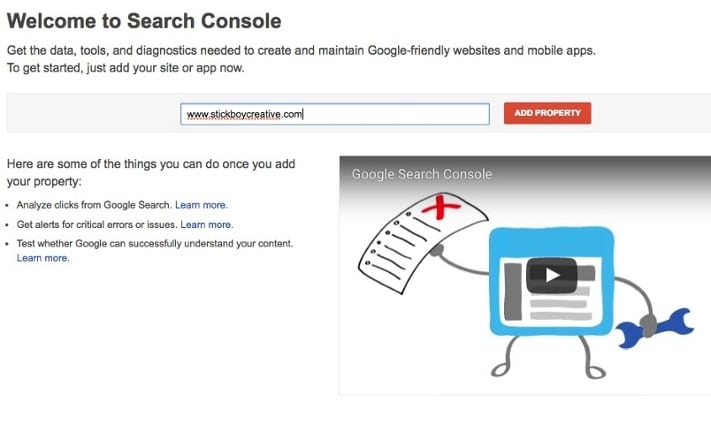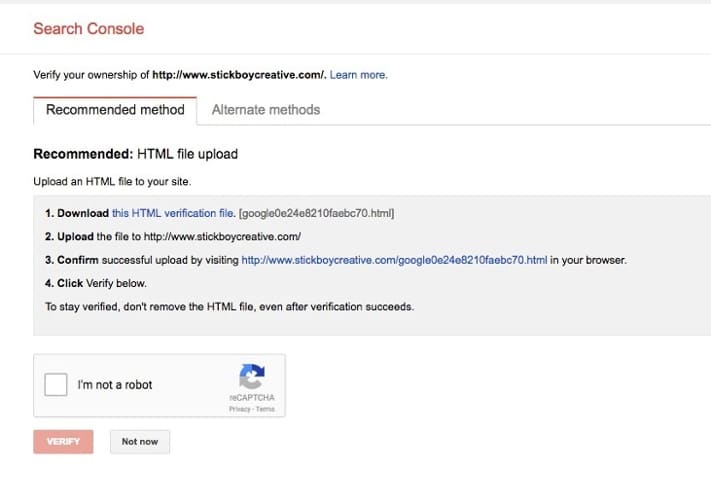25 June 2016
Want To Rank Better On Google? You’ll Need These 4 Things
Your website is up and the biggest source of traffic and leads is from a company in Mountain View called Google. So how does Google determine your search ranking?
Why is your site hidden deep in the results so when your potential customer is searching for what you offer? If they can’t find you, they’re going to your competition instead of you.
How do you fix this? What is the secret to getting better rankings on Google? Read on and you’ll find a simple 4 step process to do just that.

Step 1: You’re Indexed
The first thing above all else is to make sure that Google knows your site exists! Google needs to index your website’s pages to ensure that it knows where they are, what content is on them, etc.
The way you do this is by logging into the Google Search Console.
Once logged in, type in the URL and click “Add Property”:

Next, you’ll need to verify that you own this domain. Google provides a few steps to do this, the simplest one is with an HTML file upload. You merely download their verification file and upload it via FTP to your server. Once there, just click the link and Google will see that your site is set up.

Once verified, you can monitor the progress of Google indexing your site. It may take a few days to do, so now is a great time to add a sitemap.
A sitemap is an XML file that lists all of the URLs a website contains – pages, images, videos, etc.
It’s formatted with XML tags so the robots deep inside Google can know where everything is on your website. It’s an essential step to indexing and can help speed up the process tremendously.
As your website grows, it’s important to monitor how Google has you indexed and make sure there aren’t any URL errors. If there are, you’ll want to jump on those since that could be hurting your user’s experience on your site.
You can log into the Search Console at any time to check on your site and make sure you’re not losing out on valuable SEO due to an error that could be a very simple and quick fix.
Step 2: Good, Relevant Content
To Google, they want your website to provide value to what a person is looking for. When a person goes to Google and types in, “best pet grooming in Fort Myers”, it’s relying on Google to come back with what that person thinks would be the best pet grooming in Fort Myers.
So when the search results come back, Google is effectively telling the person, “this is the list of pages I think would best give you what you’re looking for”.
Google then wants that person to click on a link and find exactly what they’re looking for – because they’re more likely to come back and use Google to search for something again.
So the key to keeping both Google and your visitor happy is by having relevant, unique, and quality content on your website. The more you have, the more likely visitors will find your website valuable, and the more likely Google is going to move your pages upon its list of results.
So what kind of content do you need? It can be a variety of things, but this can get you started:
- Articles
- Blog Posts
- Infographics
- Tutorials
- Podcasts
- Videos
- “How To” guides and FAQs
It can seem daunting at first to develop all of this, but the investment is well worth it. Google loves to see content like this in its results because it means your site will provide more value to the person using Google to search.
The good news for you is this kind of content can be repurposed and used in a variety of ways from social media, to email campaigns, and so on.
Start small, but make sure to continually provide content so that your website provides the value that Google wants to see. Then as you see the results come back, start investing more into it.
Step 3: Backlinking
Backlinking is the technique of building links back to your website from other websites on the web. Google has stated recently that this is less important than it was in the past, but they still use it as a vital metric to determine what Google calls your website’s authority.
Authority is what Google uses to determine the quality of a link from one site to another. If there is a website that has quality content, is indexed well, and regularly appears at the top of search results, then it has a good amount of authority if it links to another website.
Think of a link like an endorsement. The better the website is that’s recommending you, the better that endorsement is going to be.
How do you get these? There are essentially 2 kinds:
White Hat – good quality, organic if possible.
Black Hat – low quality, essentially spam.
White Hat is what you want to strive for. These can be news reports, publications, guest blog posts you do – other websites that link directly to you based on some kind of value you provide. Here’s a great scenario:
You create an industry-specific infographic that helps explain some very technical statistics about your audience. It’s easy to digest and people love it because it provides a great understanding of something that people are struggling with.
So you let people freely use the infographic as long as they link back to your website as credit. Soon people are putting it on their blog, their social media profiles, any place they can because they want their audience to get the same value that you initially provided.
Each time this is shared again, it’s creating a new “backlink” to the original post. Google sees all of these people linking back to this page and therefore knows that many people are looking for this topic and find the information useful. So Google will start to rank it higher.
Infographics are just one example. You can also try any of the following:
- Guest Blog Posts
- Vendors, suppliers, partners linking to your site
- Local search profiles and social media profiles
- Industry directories and advertisements
Step 4: Adwords
Many of the methods above take time, which is important because Google takes its search rankings very seriously. They don’t just shuffle things around randomly, they want to continue to provide good value to people looking for things on the web.
So let’s say you did the above. You have Google Search Console configured. You’re starting to develop quality content and hosting it on your blog. You’ve reached out to business partners and industry experts to provide some good links.
These things are like investing for retirement – they’re important and can pay massive dividends down the road if you stick with it. But what about now? How can we improve our ranking in the short term?
Let’s buy our way to the top!
Google Adwords is the advertising platform that Google provides to allow individuals and businesses to purchase rankings for specific keywords. There are two types of models:
Pay Per Click – You only pay a set amount when someone clicks on your ad. You choose the maximum you’re willing to pay for each individual click, as well as the maximum you’ll pay throughout the day.
Pay Per Impression – You’ll instead pay for the amount of search results your ad will appear on, regardless if a user clicks on it or not. You’ll get to set the maximum amount you’ll pay each day.
Adwords is incredibly powerful and has many advanced features and reporting, so let’s just cover the very basics.
First, you’ll need a list of keywords you want to rank for. Think of these as the search terms you’ll want to show up under. In the example above, we may use “dog groomer”, “dog spa”, “dog nails trimming”, “dog boarding” etc.
These can be different phrases people would use to search for a service or product you provide.
With those keywords, you’ll need to set those up into “groups” and each group has an ad. The groups are just a set of similar keywords that can show the same ad – an example would be “dog groomer” and “dog nails trimming” because those are relatively similar, whereas “dog spa” and “dog boarding” aren’t.
Now that we have “Dog groomer” and “dog nails trimming”, the next thing we need is to create an ad. An ad on Google Adwords consists of basically this formula:
- Headline
- The first line of copy
- The second line of copy
- Display URL telling the person where they’ll be going
- A link to the page the person will go to when they click the ad
There are more features we can add to these like phone numbers, pages, ratings, etc – but an ad should always contain at least those 5 things. With this ad created, the keywords are chosen, and your budget is set.
Then when someone goes to Google and searches for “dog groomer Fort Myers”, Google will look at all of these factors:
- Keyword’s relevance to the search phrase
- Ad quality and relevance to the keyword
- Page linked from the ad’s relevance to the ad
- Budget set for each click
It will then take all of these and assign your ad a place on its search results. The more relevant and higher quality your ad, page, and keywords are to the search term, the higher your ranking will be (and cheaper due to Google’s clever ad scoring mechanism).
With all 4 of these steps, you’re well on your way to having good rankings on Google.
The main key is to think about it as providing a service to your visitor, and not trying to “game the system”. Providing good quality, relevant content to your visitor and giving them exactly what they’re looking for is what Google wants to see. The more effective you are at it, the better your search results.



